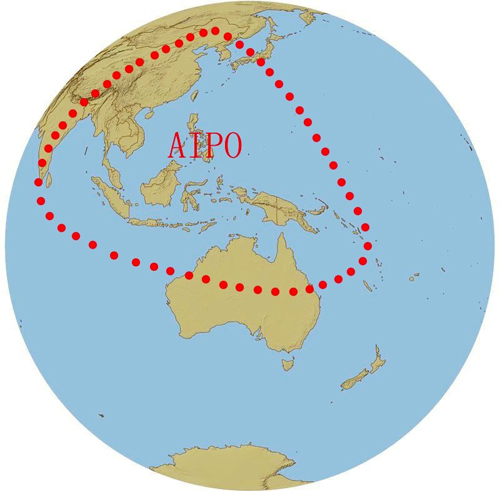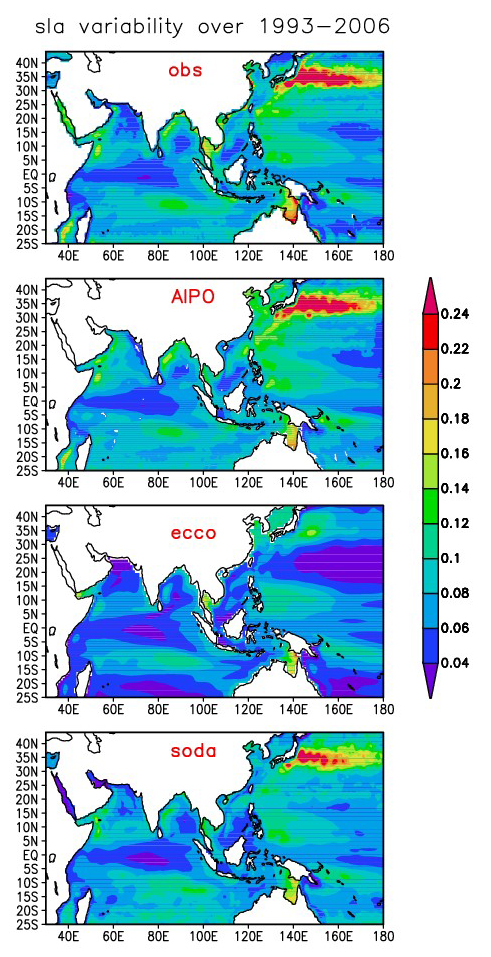The joining area of Asia and Indian-Pacific Ocean (AIPO) refers to the ocean area that surrounds the East Asian and South Asian continents and connects to the Western Pacific and the Indian oceans. The air-sea interaction in the area is one of the key factors that affect large-scale climate variation in China. Therefore, it is important to develop an ocean data assimilation system and deliver high resolution ocean state estimation via reanalysis for the area.

The joining area of Asia and Indian-Pacific Ocean (AIPO) enclosed by red dots (Diagram plotted by IAP)
The existing global ocean reanalysis datasets such as Estimating the Circulation and Climate of the Ocean (ECCO) and Simple Ocean Data Assimilation (SODA) can cover the region but the horizontal resolutions are relative low . With such resolutions, it’s difficult to resolve the complicated coastal lines such as in the Indonesian Through Flow (ITF) region that connects the Indian Ocean and the Pacific Ocean. Strong activities of mesoscale eddies happen in the region, such as in the Korushio extension region and the South China Sea. An eddy-permitting resolution is necessary to represent those mesoscale induced variabilities.

Interannualvariablities of sea level anomalies (a) observations (b) assimilation experiment, (c) ECCO and (d) SODA. (Figure plotted by IAP)
Scientists from Institute of Atmospheric Physics developed an ocean data assimilation system based on the EnOI method. They presented the thinning of observations (super-observing) and domain partitioning for lower computational cost, and used a different temperature-salinity assimilation scheme corresponding to the layer model (HYCOM) to assimilate layer thickness observations, calculated from observed temperature and salinity profiles, and to adjust the model layer thickness and current fields. They then assimilated temperature or salinity observations to adjust the model temperature or salinity, followed by diagnosing the model salinity or temperature.
A 14-year reanalysis product (1993-2006) is generated by assimilating various types of observations such as in-situ profiles from ARGO, XBT, CTD, TAO etc., remotely-sensed sea surface temperature and altimetry data into the HYCOM model. A series of quantitative and qualitative evaluations was carried out by the comparisons with independent in-situ profiles, sea surface current, drifters, and tide gauges. It’s found that the resultant reanalysis from the assimilation system reconstructs the basin-scale ocean circulation and mesoscale eddies, captures seasonal or interannual variabilities with strong correlations with observations and reduced RMSEs, and shows good agreement with tide gauges and with observed ITF transports. Moreover, It outperforms SODA and ECCO products in these aspects.
Reference: YAN C. X. , J. ZHU, and J. P. XIE, 2015: An Ocean Data Assimilation System in the Indian Ocean and West Pacific Ocean. Adv. Atmos. Sci., doi: 10.1007/s00376-015-4121-z. (in press)
Contact: Dr. YAN Changxiang, ycxlasg@mail.iap.ac.cn







